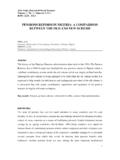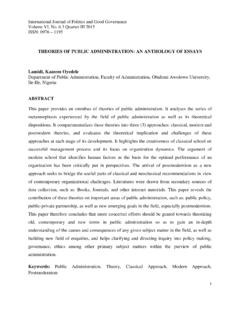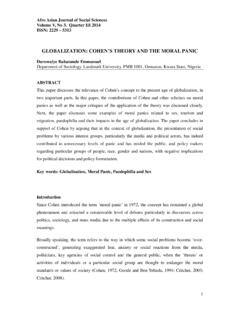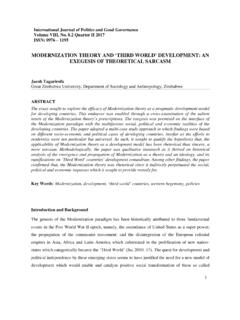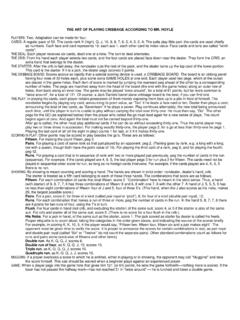Transcription of UNDERSTANDING DEMOCRATIC LEADERSHIP: SOME KEY …
1 Afro Asian Journal of Social Sciences Volume 3, No. Quarter I 2012 ISSN: 2229 - 5313 1 UNDERSTANDING DEMOCRATIC leadership : SOME KEY ISSUES AND PERCEPTION WITH REFERENCE TO INDIA S FREEDOM MOVEMENT SARBAPRIYA RAY Assistant Professor, Dept. of Commerce, Shyampur Siddheswari Mahavidyalaya, Calcutta University, India ISHITA ADITYA RAY Assistant Professor, Dept. of Political Science, Bejoy Narayan Mahavidyalaya, Burdwan University, India Abstract Appraising the concept of DEMOCRATIC leadership is essential in UNDERSTANDING both DEMOCRATIC leadership and the progress made in DEMOCRATIC movements. However, while the definition of DEMOCRATIC leadership is conflicting and insufficient in the leadership literature, there is no clear and well-developed definition of the term.
2 At the very outset, the study appraises the definitions of DEMOCRATIC leadership found in the literature. Also this study suggests a structure of DEMOCRATIC leadership in DEMOCRATIC movements that has been applied in the context of India s freedom movement against British s tyrannical regime. The structure includes the contexts, motivations, characteristics, and outcomes of DEMOCRATIC leadership in DEMOCRATIC movements. The study considers sacrifice, courage, symbolism, citizen participation, and vision as major characteristics in the display of DEMOCRATIC leadership in various political, social, and cultural contexts. This study only pays attention to DEMOCRATIC leadership in such movements in India and considers Mahatma Gandhi of India as ideal model of DEMOCRATIC leadership in DEMOCRATIC movements.
3 Applying the framework to Mahatma Gandhi of India, the study considers him as typical model of DEMOCRATIC leadership in DEMOCRATIC movements for achieving democracy in British ruled India because Mahatma Gandhi demonstrated crucial characteristics of DEMOCRATIC leadership . Above all, characteristics of DEMOCRATIC leadership that were shown by Mahatma Gandhi are discussed and compared with the framework of DEMOCRATIC leadership in DEMOCRATIC movements. Finally, the study concludes with some critical comments. Afro Asian Journal of Social Sciences Volume 3, No. Quarter I 2012 ISSN: 2229 - 5313 2 Introduction Today we are the citizens of a free and DEMOCRATIC country, India, but 64 years back, India was not a liberated nation.
4 British ruled India and a long struggle was carried out to achieve freedom for India. This Indian freedom struggle could have been an entirely impossible dream if it had not been people like Mahatma Gandhi, Pt. Jawahar Lal Nehru, and Netaji Subash Chandra Bose. The whole India was guided competently by these people towards the attainment of independence. We call them leaders. The question here arises: why were these people chosen as leaders and what were their characteristics? The answer probably lies in the critical analysis of this article. During the course of DEMOCRATIC movement in liberating British ruled India, DEMOCRATIC leadership played crucial function. Therefore, appraising the definition of DEMOCRATIC leadership is essential in UNDERSTANDING both DEMOCRATIC leadership and the progress made in DEMOCRATIC movements.
5 However, while the definition of DEMOCRATIC leadership is conflicting and insufficient in the leadership literature, there is no clear and well-developed definition of the term. It often happens that when any work has to be carried out in a group situation for the attainment of goal, one person is chosen who leads the group. This person is called the leader and it is because of his/her characteristics that this person is chosen and given the title of a leader. Groups and organizations of all types develop and succeed under an effective leadership . A good leader is not only a good commander but is also able to extract work from his followers and channelise them towards the attainment of the goal.
6 So, not only giving commands but also acceptance of requests also becomes an essential part of the leadership behavior. The leader applies his qualities and skills for achieving the group goals. So we can define as "Leaders are those who have the ability to influence the behavior of others without the use of force." A leader has to have some characteristics which differentiate him from other people. Some characteristics of successful leaders are that they are adaptable to situations, alert towards the social environment, cooperative, decisive, dependable, assertive, persistent and self-confident, knowledgeable. leadership cannot survive without follower-ship. It is the willingness of people to follow that makes a person leader.
7 People also follow those whom they witness as providing Afro Asian Journal of Social Sciences Volume 3, No. Quarter I 2012 ISSN: 2229 - 5313 3 means of achieving their goal. The personality characteristics of the leaders are different than other people. DEMOCRATIC leadership : Meaning The DEMOCRATIC leadership style is a very open and collegial style of running a team. Ideas move freely amongst the group and are discussed openly. Everyone is given a seat at the table, and discussion is relatively free-flowing. DEMOCRATIC leadership , also known as participative leadership , is a type of leadership style in which members of the group take a more participative role in the decision-making process.
8 Researchers have found that this learning style is usually one of the most effective and leads to higher productivity, better contributions from group members and increased group morale. DEMOCRATIC leadership works best in situations where group members are skilled and eager to share their knowledge. It is also important to have plenty of time to allow people to contribute, develop a plan and then vote on the best course of style is needed in dynamic and rapidly changing environments where very little can be taken as a constant. In these fast moving organizations, every option for improvement has to be considered to keep the group from falling out of date. The DEMOCRATIC leadership style means facilitating the conversation, encouraging people to share their ideas, and then synthesizing all the available information into the best possible decision.
9 The DEMOCRATIC leader must also be able to communicate that decision back to the group to bring unity the plan is chosen. Because group members are encouraged to share their thoughts, DEMOCRATIC leadership can leader to better ideas and more creative solutions to problems. Group members also feel more involved and committed to projects, making them more likely to care about the end results. Research on leadership styles has also show that DEMOCRATIC leadership leads to higher productivity among group members. When situations change frequently, DEMOCRATIC leadership offers a great deal of flexibility to adapt to better ways of doing things. Unfortunately, it is also somewhat slow to make a decision in this structure, so while it may embrace newer and better methods; it might not do so very quickly.
10 DEMOCRATIC leadership style can bring the best out of an experienced and professional team. It capitalizes on their skills and talents by letting them share their views, rather than simply expecting them to conform. If a decision is very complex and broad, it is important to have the Afro Asian Journal of Social Sciences Volume 3, No. Quarter I 2012 ISSN: 2229 - 5313 4 different areas of expertise represented and contributing input this is where DEMOCRATIC leader shines. Anderson (1959) identified the DEMOCRATIC leader as one who shares decision making with the other members and therefore, DEMOCRATIC leadership is connected with higher morale in the majority of the situations. He denied that DEMOCRATIC leadership is associated with low productivity and high morale and that authoritarian leadership is associated with high productivity and low morale.
